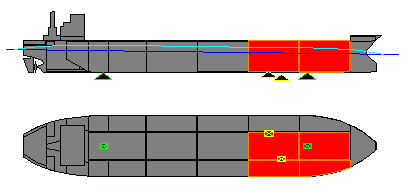Technical Assistance and the US Navy's Program of Ship Salvage Engineering (POSSE)
SUPSALV salvage engineers provide technical and operational assistance to the U.S. Navy, as well as
other federal agencies, such as the U.S. Coast Guard, Army Corps of Engineers, and Department of State.
They have extensive training and expertise in naval architecture, salvage equipment, salvage
operations and procedures, diving (qualified U.S. Navy divers), towing, and pollution abatement, and
also have thorough knowledge of capabilities and practices of the commercial salvage industry.
They are also fully equipped for "independent operations" and available for immediate mobilization
for on-scene technical and operational assistance to the U.S. Navy and other Federal Agencies.
SUPSALV salvage engineers utilize POSSE to perform most required engineering analyses. POSSE is the
most powerful salvage response software, providing capabilities to perform real-time engineering
analyses of complex ship salvage situations, including assessments of ship stability, drafts/trim,
intact or damaged structural strength, ground reaction and freeing force, oil outflow and flooding,
lightering (weight removal) plan, tidal effects, etc. SUPSALV began development of POSSE in 1989
through a cost-sharing agreement with Herbert Engineering Corporation, and has continuously updated
the program to improve capabilities and take advantage of advancing computer technology. As a
benefit of the cost-sharing agreement, POSSE is fully compatible with the commercial salvage
response software HECSALV and the commercial shipboard loading program CARGOMAX, and can also read
data files of other commercial salvage response programs, including GHS.
POSSE performs rigorous numerical integration of hull and compartment offsets to calculate volumes.
Forces (weight, buoyancy, reaction) are iterated to obtain equilibrium (afloat and aground).
Effects of hull deflection can be included. Hull girder deflections can also be calculated based on
hull girder inertias.

Notable new POSSE features include:
1. Non-rigid ground definition, including Multiple Point Grounding (MPG) analysis: Allows the salvage
engineer to evaluate the effects of multiple contact points (up to and including complex drydock
blocking analyses), a simple shelf, or a penetrable shelf.

2. Tide/Lightering Sequence (TLS): Allows the salvage engineer to calculate and display time-phased calculations
of tide height, ballasting/deballasting/transfer of liquids from intact tanks, transfer of liquids
and oil/water outflow/ flooding from damaged tanks, ground reaction, bending moments, shear forces,
hull girder stresses, etc. A lightering plan, including transfer rates, start and stop times, and
discharge amounts can be developed and printed for distribution to the salvage team.
 Add Content...
Add Content...
3. Hull axis rotation: Allows the salvage engineer to model capsized vessels and conduct detailed
analyses for parbuckling/righting
4. Interfaces with the U.S. Navy's Ship Motion Program (SMP) and Ultimate Strength Program (ULSTR):
Allows the salvage engineer to provide improved evaluations of dynamic wave bending moments and
ultimate/residual strength characteristics of intact and damaged hull structure. SMP's results can
also be used to provide detailed ship motions information (wave slap, accelerations, etc.).
5. Windows-based operation: Salvage response portions of POSSE have been converted to a 32-bit Windows
application. Conversion of the modeling portion of POSSE should complete by the end of Fiscal Year 01.
The key to successful utilization of POSSE is the experienced salvage engineer with solid working
knowledge of naval architecture and salvage operations. Detailed ship naval architecture information
must be combined with practical knowledge of the salvage operation in order to develop an effective
and efficient salvage plan.
To provide basic overview and lessons learned of POSSE applications for actual salvage operations,
SUPSALV provides POSSE Technotes to users of POSSE and other interested parties. Any POSSE user
interested in authoring an edition of POSSE Technotes for a completed POSSE analysis should contact
the POSSE Program Manager for guidelines.